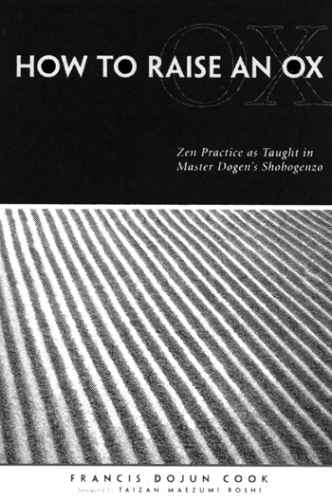 How to Raise an Ox:
How to Raise an Ox:
Zen Practice as Taught in Master Dogen’s Shobogenzo
Francis Dojun Cook
Foreword by Taizan Maezumi Roshi
Boston: Wisdom Publications, 2002
180pp.; $16.95 (paper)
“The Zen of Dogen is the Zen of practice,” Francis Dojun Cook tells us in How to Raise an Ox, a reissue of his collection of essays and translations from the works of Dogen Kigen, the thirteenth-century founder of Japan’s Soto Zen school. Cook’s purpose is to clarify what Dogen’s “Zen of practice” actually means. We can measure his success not only by the vividness of his introduction to Dogen’s thought but also by the surprise we find in discovering the breadth and diversity of “practice” as Dogen meant it.
Dogen is the great propagator, though not the originator, of the idea that practice itself is attainment. The practice of zazen, or sitting meditation, is itself the manifestation of Buddhahood. Practice “is not a means to an end. True practice is the enlightened activity of the Buddha we already are.” Zazen is the actualized expression of intrinsic enlightenment. “Practice and enlightenment are the same; to practice is to be a buddha.”
This view begs the question, “If I am already the Buddha, why should I practice at all?” Indeed, it was this very question that led Dogen on a spiritual quest to China, where he practiced until he attained awakening. His answer was that although we may intellectually acknowledge that we are Buddhas, we have not directlyrealized it, and “our unrealized Buddha-nature does not illuminate and transform our everyday lives.” Cook likens Buddha-nature here to a talent for music: it is a potential that only becomes evident through practice.
But isn’t that the same as saying that Buddha-nature is a potential that must be cultivated in order to be actualized? We cannot turn to Dogen for dialectical analysis of Buddhist philosophy, but the question that drove him in his youth has always been the basic critique made by the analytical, gradualist schools of Buddhism. They view the notion that we are already perfectly complete buddhas to be nonsense, because it is obvious that we are suffering beings who must practice a path of gradual development in order to become buddhas.
The split between the inherent and gradualist views is the central fault line that divides two main approaches to Buddhist practice. What is most delightful in Cook’s presentation of practice according to Dogen is the revelation that the core practices that constitute the gradualist path are fully integrated with the view of inherent Buddhahood, underlying the practice of zazen the way a cushion supports the meditating Buddha.
For example, says Cook, although faith may appear superfluous to Zen, “Correct practice is based on the faith that one is already a Buddha, for there is nothing that is not the Buddha.” Here we see how the ideology of inherency ramifies into gradualist practice (and vice versa): All you need to realize your own innate Buddha-nature is to sit in meditation; but without cultivating faith, will you sit?
There are many other practices central to the gradualist project of transforming oneself from a samsaric being into a buddha that are fully integrated into Dogen’s Zen, including renunciation, or “home departure”;bodhicitta, or “arousing the supreme thought”; “deep faith in cause and effect” of karma; “paying homage” to the three jewels; and studying the sutras.
We can view these practices from the perspective of the unenlightened trainee, as the step-by-step stages of cultivating one’s impure inner potential. Or we can see them from the perspective of the Buddha, as the spontaneous manifestation of innate perfection. Are we climbing the mountain from below, or swooping down from above?
When the rhetoric of ideology slips away, we are left with the indispensable power of continuous practice, the “constant effort to awaken, over and over, as each new experience arises.” Dogen says, “this continuous practice is neither one’s own effort nor someone else’s effort; it is pure, continuous practice that transcends the opposition of self and others.”
“Every person who truly undertakes Zen training,” says Cook, “does so in the belief that there is something wrong with him or her. . . . Zen training shows us what we really are, our reality as distinct from the idealization. Then, with luck and hard work, we discover that what we really are is perfect and has been all along.” ▼